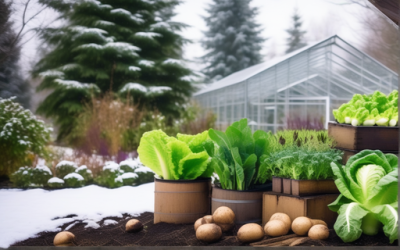Off Grid Home › Forums › Gardening and Permaculture › Growing Your Own Food: Off-Grid Gardening and Permaculture in Winter
Tagged: garden, gardening, permaculture, winter
- This topic has 1 reply, 1 voice, and was last updated 1 year, 6 months ago by
WrethaOffGrid.
-
AuthorPosts
-
December 16, 2023 at 6:18 AM #129113
WrethaOffGrid
Moderator Are you eager to continue growing your garden, even during winter? Do you want to explore off-grid gardening and permaculture techniques that can be applied in colder climates? In this post, we will delve into winter gardening and discover how off-grid gardening and permaculture principles can be adapted to thrive in the winter season. Let’s explore some key points!
Are you eager to continue growing your garden, even during winter? Do you want to explore off-grid gardening and permaculture techniques that can be applied in colder climates? In this post, we will delve into winter gardening and discover how off-grid gardening and permaculture principles can be adapted to thrive in the winter season. Let’s explore some key points!Benefits of Winter Off-Grid Gardening and Permaculture:
- Extended Growing Season: Winter gardening allows you to extend your growing season and enjoy fresh produce even when traditional gardening is impossible.
- Sustainable Food Source: By growing your food in winter, you reduce your reliance on imported produce and support a more sustainable food system.
- Nutrient-Rich Harvest: Cold weather can enhance certain crops’ flavor and nutritional value, providing you with a bountiful and healthy harvest.
- Engaging Outdoor Activity: Winter gardening can be a rewarding and enjoyable outdoor activity during the colder months, keeping you connected with nature.
Techniques for Winter Off-Grid Gardening and Permaculture:
-
Cold Frames and Hoop Houses:
- Build cold frames or hoop houses to protect your plants from harsh winter weather, providing a warmer microclimate.
- Use transparent covers like polyethylene or greenhouse plastic to allow sunlight to enter while retaining heat.
-
Season-Appropriate Crops:
- Choose winter-hardy crops that withstand colder temperatures, such as kale, spinach, Brussels sprouts, and winter lettuce varieties.
- Consider root vegetables like carrots, turnips, and beets, which can be harvested throughout the winter.
-
Mulching and Soil Protection:
- Apply a thick layer of mulch around your plants to insulate the soil and regulate temperature fluctuations.
- Use organic materials like straw, leaves, or wood chips to protect the soil from freezing and prevent weed growth.
-
Cold Tolerant Varieties:
- Opt for cold-tolerant vegetable varieties specifically bred for winter gardening.
- Look for seed catalogs or consult local nurseries for recommendations on varieties suitable for your region’s winter conditions.
-
Indoor Gardening:
- Utilize indoor gardening techniques, such as growing herbs and microgreens on windowsills or setting up a small greenhouse indoors.
- Supplement natural light with artificial grow lights to ensure plants receive adequate light for growth.
-
Season Extension Methods:
- Experiment with season extension methods like row covers, cloches, or low tunnels to provide additional protection and warmth to your plants.
Winter off-grid gardening and permaculture offer exciting opportunities to continue growing your own food and stay connected with nature throughout the colder months. By implementing these techniques, you can enjoy fresh, homegrown produce even in winter’s grip. So, bundle up, embrace the season, and embark on a rewarding journey of winter gardening. Let me know what you like to grow in the colder months, what are your successes, and what do you struggle with. Happy growing!
December 16, 2023 at 6:35 AM #129117WrethaOffGrid
ModeratorIn winter, my garden, like most people (I believe), tends to slow down. I manage to keep a few perennial herbs going all winter, specifically garlic chives and chocolate mint. The chives are in a protected place, so they don’t tend to be bothered too much by the cold, and the mint I grow in a pot, so I bring it up into a mostly enclosed space next to a large window. It gets cold, but as long as I remember to water it before a hard freeze, it’s still out there, bright green and cheery the following morning.
Being in the high desert mountains in far west Texas, we can have some bitterly cold nights, but generally, as long as the sun comes out during the day, the temps tend to warm up nicely, even up into the 50s or 60s F. One of the things I do have to watch out for is the wildlife. We don’t typically have larger critters, mainly because of the fenced yard and the dogs, but the smaller ones, mice, voles, squirrels, and the occasional skunk, will take advantage of my unguarded plants overnight, especially when everything else is dry and crispy. I have some wire enclosing my garlic chives, which keeps most of the smaller critters at bay, and there is a bit of chives that have seeded outside of the wire enclosure so the mice do have something they can get to if they wish.
Oh, I almost forgot; I have a few random green onions that grow in a sort of window box just outside of my living room. I will buy a few green onions in spring from the grocery store, I’ll leave an inch or so of the root end and stuff it into the dirt. By mid-summer, my planter box is brimming with green onions, I’ll chop a bit for a meal and leave the rest. I do have to compete with the mice, sometimes, it gets pretty heated, and I have to take action against the mice. Honestly, I’m surprised that there are any onions left out there right now. There are only a few but they are still growing, and if I think about them, I’ll take scissors in hand and snip some greenery to add to a dish.
-
AuthorPosts
- You must be logged in to reply to this topic.